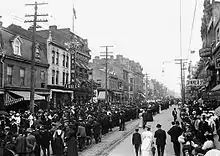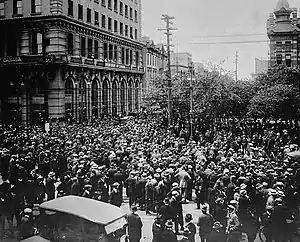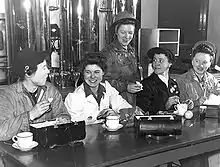Timeline of labour issues and events in Canada
This is a timeline of labour issues and events in Canada.
1870s

- 1872 – The Toronto Typographical Union goes on strike on March 25 over its demands for a nine-hour workday. Union activity then being a criminal offence, 24 members of the strike committee are jailed for conspiracy as a result of legal action taken by the editor of The Globe, Liberal Party leader George Brown. The protests that follow Brown's actions lead to Parliament passing the Trade Unions Act on June 14 which legalizes trade unions.[1]
- 1873 – A first attempt at establishing a national trade union centre is made by the founding of the Canadian Labour Union. It later dissolves in 1878.[2]
1880s
- 1883 – The Trades and Labour Congress of Canada (TLC), a Canada-wide central federation of trade unions, is formed.
- 1889 – Royal Commission on the Relations of Labour and Capital[1]
1890s
- 1894 – Labour Day is made a federal public holiday.[3]
1900s
- 1900 – Parliament passes the Conciliation Act and establishes the federal Department of Labour[1]
1910s

The Winnipeg general strike in 1919
- 1912–1914 – Great Coal Strike on Vancouver Island, aka Vancouver Island War,[4] after which miner Joseph Mairs died in jail having received no medical attention. A memorial cairn stands in Ladysmith, British Columbia.
- 1914 – The Workmen's Compensation Act, the first social insurance legislation in Canadian history, was adopted by the Legislative Assembly of Ontario.[5]
- 1917 – The Canadian Labour Party is founded on the initiative of the Trades and Labour Congress of Canada.[6]
- 1918 – The shooting death of Albert "Ginger" Goodwin sparks the Vancouver general strike, the first general strike in Canadian history.
- 1919 – Western Labour Conference in Calgary leads to creation of One Big Union.
- 1919 – Winnipeg general strike
1920s
- 1924 – An informal coalition of progressive MPs forms the Ginger Group in the House of Commons to fight for labour and social issues.
- 1925 – One coal miner was killed and many injured during a protest as a result of a major strike at the British Empire Steel and Coal Company (BESCO) in New Waterford, Nova Scotia. Davis Day was established in the memory of Bill Davis, the miner who was murdered by company police. The labour dispute resulted in the deployment of 2,000 soldiers during the largest peacetime deployment of the Canadian Army for an internal conflict since the Northwest Rebellion of 1885.
- 1929 – Death (suspected murder) of trade unionists Rosvall and Voutilainen
1930s
- 1931 – Estevan riot
- 1932 – Creation of the Co-operative Commonwealth Federation
- 1935 – On-to-Ottawa Trek
- 1935 – Battle of Ballantyne Pier
- 1938 – Bloody Sunday
- 1939 – Canada declares war on Germany
1940s

Female shop stewards at the Burrard Drydock, North Vancouver, British Columbia. The company hired more than 1000 women during World War II, all of whom were dismissed after the war to free up jobs for the men returning from armed service.
- 1940 – The Canadian Congress of Labour is founded following the expulsion of supporters of the Congress of Industrial Organizations from the Trades and Labour Congress of Canada in 1939 as a result of pressure from the American Federation of Labor.
- August 1940 – The first compulsory national unemployment insurance system in Canada is introduced; it comes into operation in July 1941.[7]
- 1945 – Ford strike of 1945
- 1946 – Introduction of the Rand formula
- 1949 – Aggregate union membership in Canada surpasses one million.[8]
- 1949 – Asbestos Strike
- 1949 – Controversial American labour unionist Hal C. Banks comes to Canada to assist in a labour dispute between rival shipping unions.[9]
1950s
- 1952 – First Peace Arch concert by musician and labour activist Paul Robeson
- 1956 – The Canadian Labour Congress is formed through the merger of the Trades and Labour Congress of Canada and the Canadian Congress of Labour.[10]
- 1956 – The Mine, Mill and Smelter Workers hold a national convention in Sudbury, Ontario, at which singer and activist Paul Robeson gives his first concert outside the United States since being placed under a travel ban by the United States government in 1950.
1960s
- 1961 – The New Democratic Party is founded as the successor to the Co-operative Commonwealth Federation and establishes a formal relationship with the organized labour movement.[11]
- September 10, 1961 - A Mine, Mill and Smelter Workers meeting at the Sudbury Arena, regarding the union's controversial proposal to merge with the United Steelworkers, erupts into a riot.[12]
- 1963 - Reesor Siding Strike
- 1963 – The Canadian Union of Public Employees is formed through from the merger of the National Union of Public Employees and the National Union of Public Service Employees.[13]
- 1965 – Wildcat postal strike, leading to the extension of collective bargaining rights to the majority of the public service
- 1967 - The international Mine, Mill and Smelter Workers merge with the United Steelworkers. Local 598 in Sudbury, Ontario is the only Mine Mill local in the world to reject the merger, instead continuing operations as an unaffiliated union organization until 1993.
- 1968 - Air Canada agents in British Columbia begin work-to-rule over a dispute over the industrial relations department's bargaining methods.[14]
- 1969 - Murray-Hill riot
1970s
- 1971 – Introduction of paid maternity leave through unemployment insurance
- 1975 – Grace Hartman is elected as the second president of the Canadian Union of Public Employees, becoming the first woman to lead a major labour union in North America.[15]
- September 15, 1978 - The Inco Strike of 1978 begins in Sudbury, Ontario. Workers are out on strike for almost nine months, until June 7, 1979.
- June 1979 – The United Food and Commercial Workers is formed through the merger of the Amalgamated Meat Cutters and the Retail Clerks International Union.[16]
1980s
- 1985 - The Canadian Auto Workers become independent of their former parent union, the United Auto Workers. This process is later documented in the film Final Offer.
- 1986 - Six-month-long strike at the Gainers meatpacking plant in Edmonton
1990s
- 1992 - A bomb at the Giant Mine in the Northwest Territories kills nine replacement workers. Striking mine employee Roger Warren is eventually convicted on nine counts of second-degree murder.
- 1993 - Local 598 in Sudbury, Ontario, which was the only Mine Mill local in the world not to join the United Steelworkers when the two unions merged in 1967, joins the Canadian Auto Workers.
- 1998 - Teenagers Jennifer Wiebe and Tessa Lowinger successfully unionize a McDonald's franchise in Squamish, British Columbia. However, the union is decertified in July 1999.
2000s
- November 22, 2000 - A McDonald's restaurant in Montreal is unionized. The location is closed down on August 31, 2001, with the owner claiming economic pressures due to a rent hike. This is later documented in the film Maxime, McDuff & McDo.
- 2004 - CN Rail workers strike
- 2005 - Wal-Mart closes its Saguenay, Quebec store which became the first store of its brand in Canada being unionized.
- May 29, 2006 - Toronto Transit Commission workers stage a one-day wildcat strike.
- April 26, 2008 - 2008 Toronto Transit Commission strike
- September 19, 2008 - A fire destroys the historic Sudbury Steelworkers Hall in Sudbury, Ontario.
- December 10, 2008 - OC Transpo drivers and mechanics strike
- June 22, 2009 - 2009 City of Toronto inside and outside workers strike
- July 13, 2009 - Workers at Vale's operations in Sudbury embark on a yearlong strike over contract concessions.[17]
2010s
- July 5, 2010 - A tentative resolution of the Vale strike in Sudbury is announced.[17]
- September 11, 2012 - Ontario Premier Dalton McGuinty and the Liberal party pass Bill 115 'Putting Students First Act 2012', thereby eliminating the rights of all teachers in the province to go on strike for the next two years. Bill 115 also freezes wages, grants ten sick days per year (down from twenty) and eliminates banked sick days from previous years. Unions state that this bill is a violation of their members' rights under the Charter of Rights and Freedoms and that the bill violates the Ontario Labour Relations Act of 1995.
- February 4, 2012 - in Halifax, Amalgamated Transit Union went on strike, crippling the city's public transportation until March 14, 2012. Transit workers were denied salary or compensation increases, due to a reported $3M deficit.[18]
- 2013 – Unifor is formed through the merger of the Canadian Auto Workers and the Communications, Energy and Paperworkers Union of Canada, becoming the largest private-sector union in the country.
- 2019 - SMWIA ICI members Go on strike in Ontario for 8 weeks May - June first strike in 30 years for that organization.
Footnotes
- Phillips, Pattie (September 4, 2009). "Highlights in Canadian Labour History". CBC News. Retrieved June 5, 2016.
- Rouillard & Bullen 2013.
- Marsh 2016.
- "Vancouver Island War", Knowledge Network preview/summary video (3 minutes)
- Jennissen 1981, p. 55.
- Angus 2004, p. 95.
- Smith 2013.
- Palmer et al. 2015.
- Canada's Sweetheart: The Saga of Hal C. Banks – NFB – Collection
- Miller 1975, p. 311.
- Erickson & Laycock 2015, pp. 13–15.
- "Fighting the good fight: Homer Seguin tells his story" Archived 2012-03-08 at the Wayback Machine, Northern Life, October 15, 2008. northernlife.ca
- Laxer 1976, p. 127.
- "Air Canada Hit By Work-to-Rule", The Sun, Vancouver, British Columbia, Canada, pp. 1–2, 9 December 1968, retrieved 28 November 2016
- "1973 – 1982: CUPE Becomes a Seasoned Political Force". Canadian Union of Public Employees. 2014. Retrieved June 6, 2016.
- Legrande, Linda (1979). "Merger of Retail Clerks, Meat Cutters Created Union Exceeding 1.2 Million". Monthly Labor Review. Bureau of Labor Statistics. 102 (9): 56–57. Retrieved June 6, 2016.
- "Vale reaches deal with workers at Sudbury nickel mine". The Gazette, July 5, 2010.
- https://www.thecoast.ca/RealityBites/archives/transit-strike/
References
- Angus, Ian (2004) [1981]. Canadian Bolsheviks: The Early Years of the Communist Party of Canada. Victoria, British Columbia: Trafford Publishing. ISBN 978-1-4120-3808-9.
- Erickson, Lynda; Laycock, David (2015). "Party History and Electoral Fortunes, 1961–2003". In Laycock, David; Erickson, Lynda (eds.). Reviving Social Democracy: The Near Death and Surprising Rise of the Federal NDP. Vancouver: UBC Press. ISBN 978-0-7748-2849-9.
- Jennissen, Theresa (1981). "The Development of the Workmen's Compensation Act of Ontario, 1914". Canadian Journal of Social Work Education. 7 (1): 55–71. JSTOR 23458246.
- Laxer, Robert (1976). Canada's Unions. Toronto: James Lorimer & Company. ISBN 978-0-88862-097-2.
- Marsh, James H. (2016) [2013]. "Origins of Labour Day". The Canadian Encyclopedia. Historica Canada. Retrieved June 5, 2016.
- Miller, Gordon B. (1975). "Immigration and Labour: Critic or Catalyst?". Canadian Public Policy. University of Toronto Press. 1 (3): 311–316. doi:10.2307/3549378. JSTOR 3549378.
- Palmer, Bryan D.; Frank, David; McCallum, Todd; Rouillard, Jacques (2015) [2006]. "Working-Class History". The Canadian Encyclopedia. Historica Canada. Retrieved June 6, 2016.
- Rouillard, Jacques; Bullen, John (2013) [2006]. "Canadian Labor Union". The Canadian Encyclopedia. Historica Canada. Retrieved June 6, 2016.
- Smith, D. A. (2013) [2006]. "Employment Insurance". The Canadian Encyclopedia. Historica Canada. Retrieved June 8, 2016.
External links
This article is issued from Wikipedia. The text is licensed under Creative Commons - Attribution - Sharealike. Additional terms may apply for the media files.